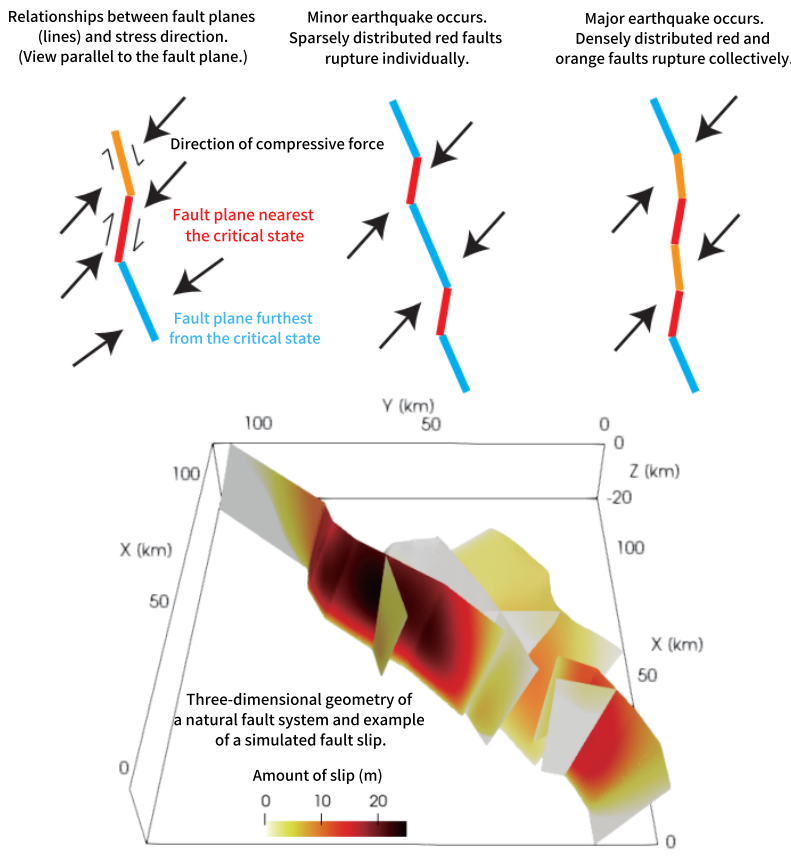DATE2022.02.21 #FEATURES#The Rigakubu News
Mysteries in Science: Can We Forecast Earthquakes from the Geometry of Faults?
Ryosuke Ando
(Associate Professor, Department of Earth and Planetary)
The 2021 Nobel Prize in Physics was awarded for research on geophysical modeling of climate change. By unraveling the complex interactions of the natural world, we are now able to predict with some accuracy the future of the earth that lies before us. In fact, modeling the natural world now allows us to make certain forecasts about seismic phenomena using methodologies other than conventional empirical approaches. Models are developed by extracting the essential factors underlying a phenomenon and transforming them into mathematical formulas. Research using models without oversimplification has revealed that the shape of a fault is one of the key factors.
An earthquake is a phenomenon in which a plate composed of hard rocks moving on the Earth’s surface is ruptured by the forces generated by deformation. Earthquakes do not occur uniformly on the Earth’s surface but are caused by shifting or slippage of weak surfaces (fault surfaces) at plate boundaries and within plates. The active faults and other geological features of the Japanese archipelago have been slowly formed into their present unique and complex three-dimensional shapes in association with many earthquakes over millions of years.
Seismic phenomena are similar to solid-liquid phase transitions. When the force acting on a fault surface gradually increases to the magnitude of the static frictional force that makes the fault surface lock up (critical point), the solid plate begins to rupture and flow locally. Predicting the time of occurrence of an earthquake on a certain fault is very difficult, akin to guessing exactly when a block of ice will start to melt without knowing its temperature. Conversely, forecasting the size of a potential earthquake is relatively easier, like estimating the temperature range of a block of ice. But to what extent can we forecast earthquakes?
Frictional forces are in reality quite complex, but the range of values for the coefficient of friction can be predicted using high school physics. One of the difficulties in predicting the occurrence of earthquakes is that it is not easy to directly measure the forces acting deep underground; however, the direction of the forces can be inferred from observations of microearthquakes that occur daily. The shapes of faults are being mapped in many places by topographic interpretation and subsurface exploration. Here, the shape of the fault and the direction of the force are important. When a single non-planar fault system is formed by faults in various directions, the forces acting on the fault planes depend on their location (see figure). Previous models tended to approximate the shape of the entire fault system by a plane, but consideration of the actual shape can reveal the spatial changes in the proximity of the critical point (rupture susceptibility), and this can provide clues to forecasting the size of the earthquake; that is, the extent of the fault system in which the rupture and slip occur.
The performance of such geophysical models in forecasting earthquakes has been validated by research groups in various countries, including the Ando Laboratory in Japan, through comparison with observational data obtained for large earthquakes across the globe. It is becoming clear that if the shape of the target fault and the pre-earthquake forces can be determined by observation, large-scale computer simulations can successfully reproduce the observed earthquakes. The start of the rupture is still difficult to model, but the locations where the fault slips significantly and where the rupture is arrested can be reproduced naturally. Many aspects of complex phenomena can now be clearly understood as effects of fault geometry.
With advances in simulation methods, computational power, and observation techniques, earthquake models promise to reproduce the complexity of the natural world in increasingly diverse ways. Forecasting the time of occurrence requires the collection of data on past earthquakes through historical and geological studies, and the development of highly sensitive geophysical observations that can detect small changes over time. Finding ways to solve the problem of earthquake forecasting through modeling that captures the essence of the problem is a key challenge in light of the possibility of a gigantic earthquake in the Nankai Trough.

Figure: The relationship between the fault plane and the direction of the force (maximum compressive stress) can serve as an indicator of the distance to the critical state where the fault ruptures. When the fault plane and the direction of the force are oblique to each other, the shear stress that displaces the fault is large and near the critical state, and when they are perpendicular to each other, the normal stress that holds the fault in place is large and far from the critical state. A large earthquake occurs when there is a dense collection of of fault planes in a fault system that is close to the critical state. By modeling the shapes of actual faults, we are able to reproduce the magnitude and fault slip distribution of large earthquakes.
― This article is from the "Mysteries in Science" series in The Rigakubu News ―


